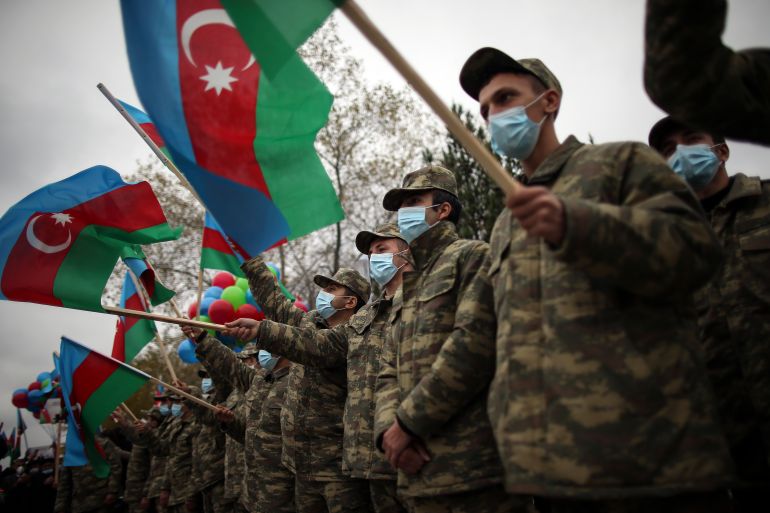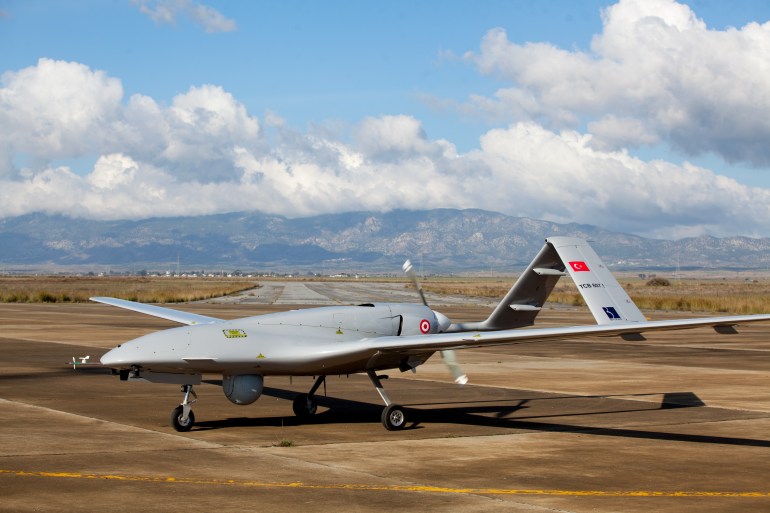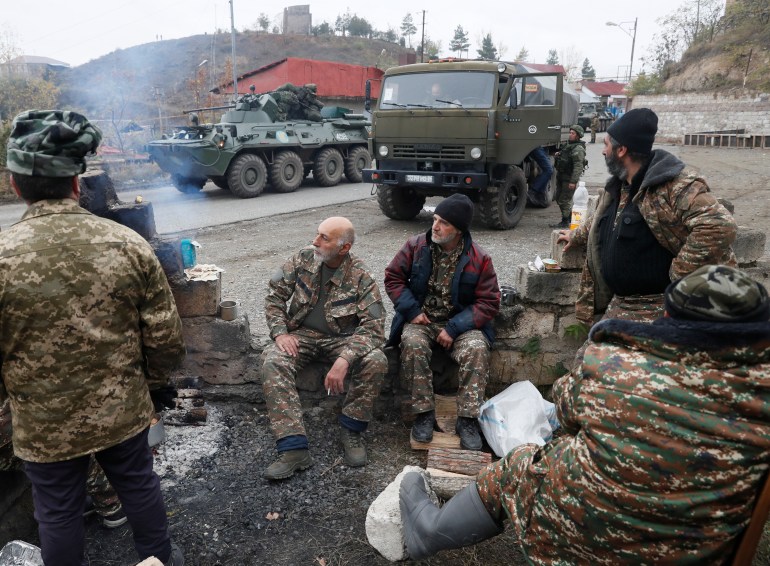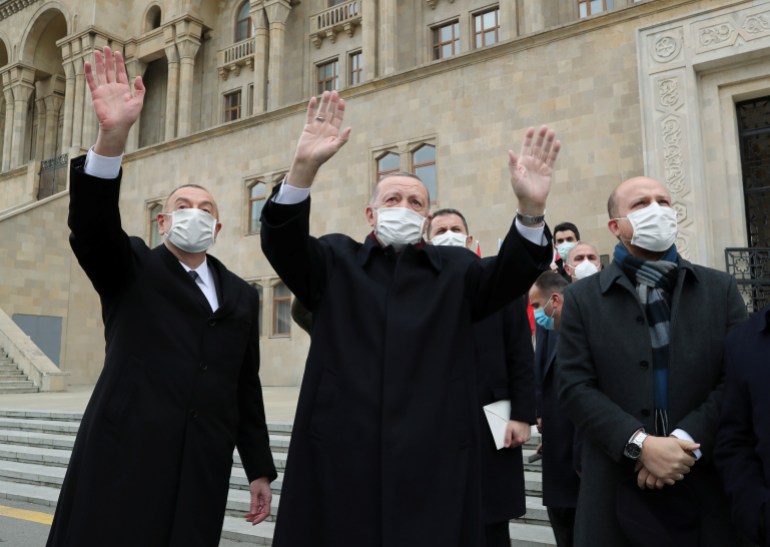Nagorno-Karabakh: How did Azerbaijan triumph over Armenia?
Azerbaijan placed bets on sophisticated, pricey weapons, while Armenia relied on old Russian-made arms and obsolete strategy, analysts say.

Azerbaijan’s 44 day offensive abruptly reshaped a decades-long, WWI-like trench war over Nagorno-Karabakh, an impoverished, breakaway region that is inside Azerbaijan’s borders but run by ethnic Armenians.
Since the mid-1990s, when the battle over Nagorno-Karabakh killed more than 30,000 people and displaced up to a million, the conflict has long been written off as one of the world’s “frozen”, unsolvable political stalemates in which resource-poor Armenia seemed to be punching well above its political and military weight.
Keep reading
list of 4 itemsPutin hails Armenian PM’s ‘courage’ in signing Karabakh deal
Nagorno-Karabakh ceasefire breached with fighting under way
Azerbaijan celebrates Nagorno-Karabakh victory, Erdogan attends
But not this time.
The victory cost Azerbaijan the lives of almost 2,800 soldiers, dozens of Azerbaijani civilians, and billions of dollars spent on weaponry.
But according to the Moscow-brokered peace deal inked in November, it got back strategic swaths of Nagorno-Karabakh, including seven districts around the mountainous region that used to be populated by ethnic Azeris but became a no-man’s land dotted with ghost towns and minefields.
How did Azerbaijan manage to triumph?
“It was a technological victory,” Alexey Malashenko, a Moscow-based political expert, told Al Jazeera.
Azerbaijan placed its bets on sophisticated, pricey weapons and new tactics battle-tested in the Middle East, while their foes relied on old Russian-made arms and obsolete stratagems they mastered in the 1990s, analysts say.
Armenia-backed troops moved around in large groups or in trucks, their trenches were wide, but not deep, their artillery was barely disguised and stayed put for days, becoming an easy target for air raids.
Their weapons were hopelessly dated, their fighter jets did not fly a single sortie, and their Russian-made Osa and Strela anti-aircraft missile systems were powerless against Baku’s most lethal battlefield upgrade – unmanned aerial vehicles (UAVs), popularly known as drones.
“Apparently, Nagorno-Karabakh’s military didn’t follow the regional wars of the 2010s that were taking place in their neighbourhood,” in Syria and Iraq, researcher Nikolay Mitrokhin of Germany’s Bremen University told Al Jazeera.
Their technical and tactical disadvantages were obvious from dozens of videos the Azerbaijani military shot from drones that targeted these large groups, jam-packed trucks, shallow trenches and exposed artillery.

Azerbaijan used Turkish Bayraktar TB2 combat drones that carry laser-guided bombs and have been battle-tested in Syria and Lybia; Israeli reconnaissance and patrol Heron and Hermes UAVs, and, lastly, “kamikaze” Orbiter drones also made in Israel.
Reconnaissance drones helped aim artillery fire that forced the Armenians to retreat.
“It explains the slow movement of the Azerbaijani army and its losses that would have been much higher in case of classic assaults in mountainous areas,” Pavel Luzin, a defence analyst with the Jamestown Foundation, a think-tank in Washington, DC, told Al Jazeera.

Swarms of combat and kamikaze drones pin-pointedly struck tanks, missile systems, artillery, trenches and troops, achieving not just military superiority, but also “demoralising” the Armenians, he said.
Luzin, other observers and Armenian officials claimed the drones were operated from Turkey – the way most US drones flying over Iraq and Syria are operated from military bases near Las Vegas.
Armenian officials and Western media also purported that Turkey deployed thousands of “mercenaries” recruited in pro-Ankara areas of Syria. Azerbaijan and Turkey denied the claims.
A parade, protests and veiled threats
This was the first military parade in history that celebrated one ex-Soviet republic’s victory over another ex-Soviet republic. It was also a combined show of force, new arms and a fledgling military alliance.
The ceremonial step of some 3,000 soldiers toting assault rifles echoed through the central streets of Baku, Azerbaijan’s capital and a Caspian port of three million, as tens of thousands of spectators, some wearing face masks, cheered, snapped photos on their mobile phones and chanted the national anthem.
A small contingent of elite Turkish commandos followed.
A deafening flock of military jets flew over them releasing smoke in the colours of the Azerbaijani flag. Dozens of Russian-made tanks and missile systems, Turkish-made armed-personnel carriers, Belarusian-made anti-tank missiles, and, of course, the Israeli and Turkish drones, were displayed during the December 10 parade.
Much older, damaged tanks and missile systems captured from Armenia were driven by on long platforms as the crowd booed.
Beaming Azerbaijani President Ilham Aliyev and his Turkish counterpart Recep Tayyip Erdogan observed the parade from a podium.

In his speech, Aliyev lambasted Armenia for expelling ethnic Azeris who lived in Armenia, Nagorno-Karabakh and the seven districts around it.
“Hundreds of thousands of Azerbaijanis who lived at the time [in what is now] the Republic of Armenia have been expelled from their lands,” Aliyev said. “Our people have for centuries lived in those lands.”
He then issued a veiled threat to continue the war by calling three Armenian regions, including the capital, Yerevan, “historically Azeri lands”.
Erdogan also looked triumphant – and echoed Aliyev’s words.
“The 30 years-old injustice is over. Our support to Azerbaijan will continue,” he said.
But will it?
Some observers predict the two leaders, who have different backgrounds and political goals, may fall out.
Erdogan is a religious school graduate who advocates the ideology of pan-Turkism, a unity of Turkic-speaking ethnic groups and nations in Turkey, northern Iran, ex-Soviet Central Asia and parts of Russia.
Aliyev, whose father and presidential predecessor Heydar was a top officer in the Soviet KGB, graduated from a prestigious diplomatic university in Moscow – and does not want Azerbaijanis to be treated as “second-rate ‘Turks’,” analyst Malashenko said.
“It’s a radical mistake to think that Azerbaijan will become Turkey’s back yard,” he said.
Three days after the parade, Aliyev praised another helmsman whose support, he said, was crucial in Azerbaijan’s victory.
“If it wasn’t for President Putin’s interference and efforts, the situation would have been different today,” Aliyev told a group of European officials in Baku.